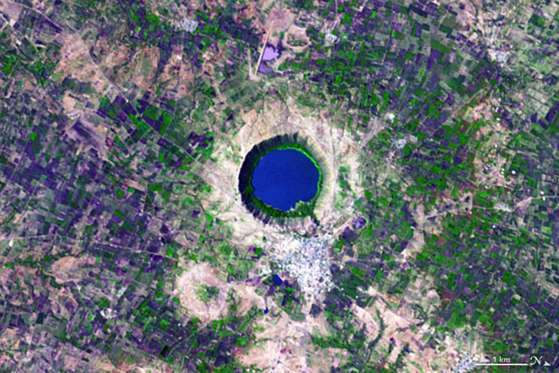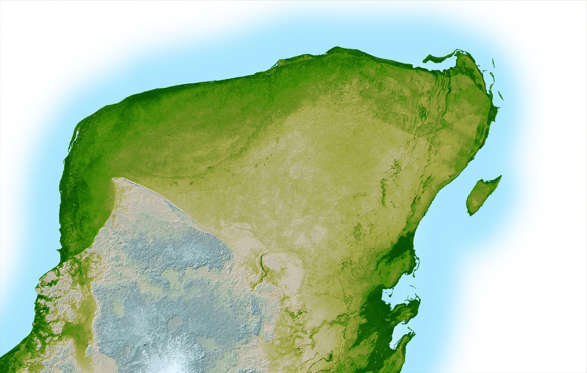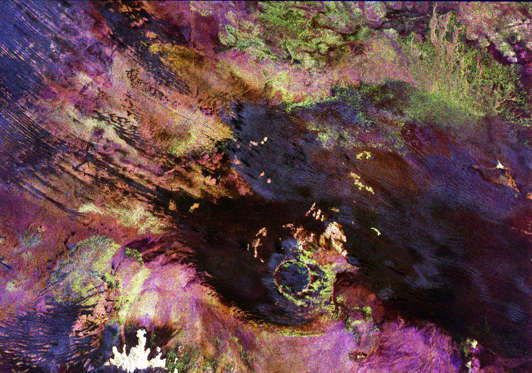Biggest Meteor Craters On Earth Created From Falling Maldek Portions
Biggest meteor craters on Earth created From Falling Maldek Portions
Located at the south-west of Johannesburg, the crater is believed to have been made by an asteroid impact on Earth some two billion years ago. With an estimated radius of 118 miles (190 km), the crater is reportedly the site of the largest energy release in the world. In 2005, it was declared a UNESCO World Heritage Site.
Lake Manicouagan is the remnant of an impact crater made approximately 212 million years ago. According to scientists, this 62 mile (100 km) wide crater was created after being hit by a 3.10 mile (5 km) asteroid.
(Pictured) Satellite image of the crater taken on June 1, 2001.
The second largest crater in the world was formed by the impact of a comet according to a 2014 study by researchers in Canada and Ireland. Colliding with Earth almost 1.85 billion years ago, the estimated diameter of the crater is 81 miles (130 km).
Spanning almost 56 miles (90 km), this crater was made by an asteroid impact some 580 million years ago. With time, the crater has been eroded but Lake Acraman, a dry lake, marks its location in South Australia.
(Pictured) Satellite image of the crater taken on Aug. 13, 1989.
The crater was made by an impactor, an asteroid or comet, that was probably about 0.62 mile (1 km) in diameter that hit Earth about 142 million years ago. The ramparts are 820 feet (250 m) high and the 2.4 mile (4 km) wide inner crater represent the base of a rebound splash that formed far below the vaporization chamber and remained frozen in the subterranean strata until it was gradually revealed by erosion.
Almost 150 meters (500 feet) deep and about 1,830 meters (6,000 feet) wide, this crater is believed to have been formed by a meteorite impact that occurred between 35,000 and 50,000 years ago. The crater rim rises roughly 20 meters (65 feet) above the surrounding land surface.
(Pictured) Satellite image taken on Nov. 29, 2004.
The crater was formed roughly 50,000 years ago when a 98.4 feet (30 meter) wide, iron-rich meteor weighing 100,000 tons struck the Arizona desert at an estimated 12.4 miles (20 km) per second. The resulting explosion exceeded the combined force of today's nuclear arsenals and created a 0.68 mile (1.1 km) wide and 656 feet (200 meter) deep crater.
The highly eroded crater exposed in the Yugorsky Peninsula is believed to have been made by an asteroid impact some 70.3 million years ago. The 40 mile (64.3 km) wide crater is linked to the nearby Ust-Kara crater and many claim that the two were formed by a single impact, in which case they would form one of the largest craters on earth at 74.5 miles (120km).
(Pictured) Satellite image of the crater taken on Sept. 27, 1992.
The crater was caused by a cataclysmic asteroid impact which, scientist theorize, may have caused the extinction of most life on Earth, including the dinosaurs, 65 million years ago. With a diameter ranging from 106 to a whopping 186 miles (170 to 300 km), if proved right could mean that the crater is the biggest on the planet.
(Pictured) In this NASA handout image released on March 7, 2003 showing the upper left portion of the Yucatan Peninsula, a faint arc of dark green is visible indicating the remnants of the crater.
The arc of the western shoreline of Chesapeake Bay is believed to have been formed by a 53-mile-wide (85 km) marine crater, first discovered in the early 1980s. The crater reportedly developed by an asteroid impact some 35 million years ago.
(Pictured) Satellite image of the impact structure taken on Jan. 1, 2002.
Located in southwest Namibia, the crater is thought to have been formed by a meteorite that collided with Earth approximately 5 million years ago. This 400 foot (130 meters) deep impact crater is 1.5 miles (2.5 km) wide whose rim stands out as a bright ring in the lower left of the image, which was taken by a radar instrument from space.
Resembling splotches of yellow and green paint, salt-encrusted seasonal lakes dot the floor of the impact structure which was formed about 1.7 billion years ago. It is currently the oldest known impact site down under.
(Pictured) Satellite image of Western Australia's Shoemaker impact structure on Aug. 9, 1991.
Located near the Kalahari Desert, this almost 43 mile (70 km) wide crater was formed by an asteroid hit some 145 million years ago. In 2006, geologists found a beach ball-sized fossil meteorite that survived the collision.
(Pictured) Sample of a large fragment of an asteroid that punched a wide hole on the Earth's surface.
Located in central Idaho and western Montana, this 600-million-year-old crater is the second largest in the US. Few remnants remain visible today.
(Pictured) Satellite image of Beverhead impact structure on Sept. 13, 1999.
Tags:
Replies to This Discussion
Have questions?
Need help? Visit our Support Group for help from our friendly Admins and members!
Have you?
Donations & Sponsorship
Connect
Visit The Temple
on Facebook:
Blog Posts
Status Update: Channeled Angelic Wisdom of the Jewels of Truth Series on Eyes & Heart, Raison d'Etre of the Jewels of Truth, and Angelic Rebirths
Posted by Atrayo on November 29, 2025 at 8:21pm 0 Comments 1 Like
The Matrix
Posted by Heth Lee on November 25, 2025 at 6:00am 0 Comments 1 Like
Ready or Not
Posted by Heth Lee on November 23, 2025 at 4:00am 0 Comments 0 Likes
Mask Off (II)
Posted by Heth Lee on November 23, 2025 at 2:13am 0 Comments 0 Likes
Mask Off
Posted by Heth Lee on November 23, 2025 at 2:11am 0 Comments 0 Likes
THELEMA vs ISLAM vs CHRISTIANITY
Posted by FRA .*. DISTURABO .*. on November 22, 2025 at 5:38am 0 Comments 1 Like
The Black Rite
Posted by Heth Lee on November 7, 2025 at 4:00pm 0 Comments 0 Likes
Channeled Fairy Wisdom of the Jewels of Truth Series on a Fae Journal Entry, Rebirths of the Fae, & Cosmology of the Astral Realms
Posted by Atrayo on November 6, 2025 at 2:43pm 0 Comments 1 Like
Sai-ßot: Genesis
Posted by Heth Lee on October 27, 2025 at 2:00pm 0 Comments 0 Likes
Channeled Angelic Wisdom of the Jewels of Truth Series on Divine Inheritance, Totality of the Self, & Paradoxical Actions by Faith
Posted by Atrayo on October 26, 2025 at 10:57am 0 Comments 1 Like
The North Star
Posted by Heth Lee on October 24, 2025 at 8:00am 0 Comments 0 Likes
Sai-ßot: Exodus
Posted by Heth Lee on October 22, 2025 at 5:00am 0 Comments 0 Likes
The Sith Lord
Posted by Heth Lee on October 20, 2025 at 11:00pm 0 Comments 0 Likes
The Weapon Master
Posted by Heth Lee on October 18, 2025 at 11:30pm 0 Comments 0 Likes
Channeled Angelic Wisdom of the Jewels of Truth Series on Heart, Pure Heart, and the Immaculate Conception
Posted by Atrayo on October 16, 2025 at 5:39am 0 Comments 1 Like
Penultimate
Posted by Heth Lee on October 10, 2025 at 12:00am 0 Comments 0 Likes
HOW ABOUT A GAME OF CARDS ?
Posted by FRA .*. DISTURABO .*. on October 9, 2025 at 4:30am 0 Comments 0 Likes
THE GOLDEN DAWN OF A NEW DAY WAS YESTERDAY
Posted by FRA .*. DISTURABO .*. on October 7, 2025 at 9:14pm 0 Comments 1 Like
DMV
Posted by Heth Lee on October 4, 2025 at 1:00pm 6 Comments 0 Likes
The Pale Horse
Posted by Heth Lee on September 30, 2025 at 6:30pm 0 Comments 0 Likes
NOVEMBER AWARENESS
Videos
© 2025 Created by Bryan
Powered by
![]()













